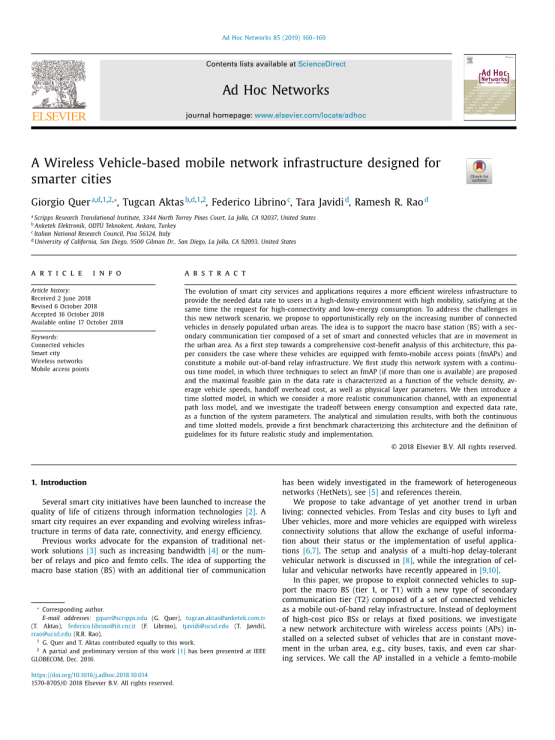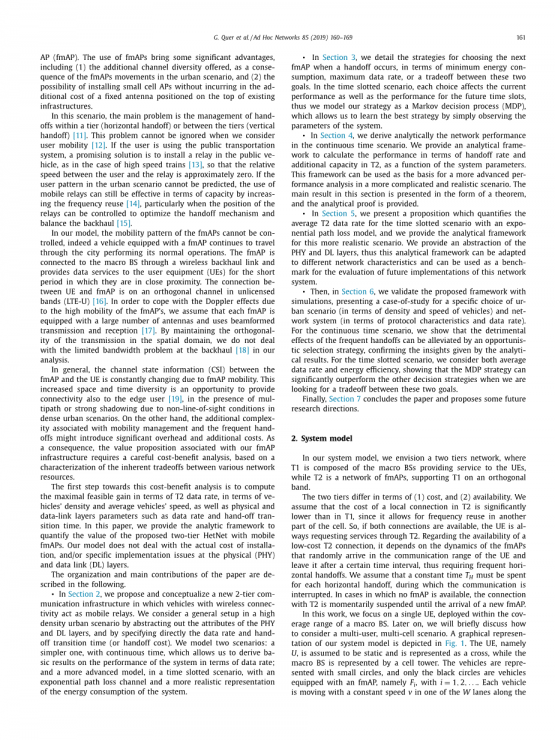

英语原文共 10 页
原文1
A Wireless Vehicle-based mobile network infrastructure designed for smarter cities
Giorgio Quer,Tugcan Aktas ,Federico Librino ,Tara Javidi ,Ramesh R. Rao
Abstract: The evolution of smart city services and applications requires a more efficient wireless infrastructure to provide the needed data rate to users in a high-density environment with high mobility, satisfying at the same time the request for high-connectivity and low-energy consumption. To address the challenges in this new network scenario, we propose to opportunistically rely on the increasing number of connected vehicles in densely populated urban areas. The idea is to support the macro base station (BS) with a sec-ondary communication tier composed of a set of smart and connected vehicles that are in movement in the urban area. As a first step towards a comprehensive cost-benefit analysis of this architecture, this paper considers the case where these vehicles are equipped with femto-mobile access points (fmAPs) and constitute a mobile out-of-band relay infrastructure. We first study this network system with a continu-ous time model, in which three techniques to select an fmAP (if more than one is available) are proposed and the maximal feasible gain in the data rate is characterized as a function of the vehicle density, av-erage vehicle speeds, handoff overhead cost, as well as physical layer parameters. We then introduce a time slotted model, in which we consider a more realistic communication channel, with an exponential path loss model, and we investigate the tradeoff between energy consumption and expected data rate, as a function of the system parameters. The analytical and simulation results, with both the continuous and time slotted models, provide a first benchmark characterizing this architecture and the definition of guidelines for its future realistic study and implementation
KEY WORDS: Connected vehicles;Smart city;Wireless networks;Mobile access points
1. Introduction
Several smart city initiatives have been launched to increase the quality of life of citizens through information technologies [2]. A smart city requires an ever expanding and evolving wireless infras-tructure in terms of data rate, connectivity, and energy efficiency.
Previous works advocate for the expansion of traditional net-work solutions [3] such as increasing bandwidth [4] or the num-ber of relays and pico and femto cells. The idea of supporting the macro base station (BS) with an additional tier of communicationhas been widely investigated in the framework of heterogeneous networks (HetNets), see [5] and references therein.
We propose to take advantage of yet another trend in urban living: connected vehicles. From Teslas and city buses to Lyft and Uber vehicles, more and more vehicles are equipped with wireless connectivity solutions that allow the exchange of useful informa-tion about their status or the implementation of useful applica-tions [6,7]. The setup and analysis of a multi-hop delay-tolerant vehicular network is discussed in [8], while the integration of cel-lular and vehicular networks have recently appeared in [9,10].
In this paper, we propose to exploit connected vehicles to sup-port the macro BS (tier 1, or T1) with a new type of secondary communication tier (T2) composed of a set of connected vehicles as a mobile out-of-band relay infrastructure. Instead of deployment of high-cost pico BSs or relays at fixed positions, we investigate a new network architecture with wireless access points (APs) in-stalled on a selected subset of vehicles that are in constant move-ment in the urban area, e.g., city buses, taxis, and even car shar-ing services. We call the AP installed in a vehicle a femto-mobile AP (fmAP). The use of fmAPs bring some significant advantages, including (1) the additional channel diversity offered, as a conse-quence of the fmAPs movements in the urban scenario, and (2) the possibility of installing small cell APs without incurring in the ad-ditional cost of a fixed antenna positioned on the top of existing infrastructures.
In this scenario, the main problem is the management of hand-offs within a tier (horizontal handoff) or between the tiers (vertical handoff) [11]. This problem cannot be ignored when we consider user mobility [12]. If the user is using the public transportation system, a promising solution is to install a relay in the public ve-hicle, as in the case of high speed trains [13], so that the relative speed between the user and the relay is approximately zero. If the user pattern in the urban scenario cannot be predicted, the use of mobile relays can still be effective in terms of capacity by increas-ing the frequency reuse [14], particularly when the position of the relays can be controlled to optimize the handoff mechanism and balance the backhaul [15].
In our model, the mobility pattern of the fmAPs cannot be con-trolled, indeed a vehicle equipped with a fmAP continues to travel through the city performing its normal operations. The fmAP is connected to the macro BS through a wireless backhaul link and provides data services to the user equipment (UEs) for the short period in which they are in close proximity. The connection be-tween UE and fmAP is on an orthogonal channel in unlicensed bands (LTE-U) [16]. In order to cope with the Doppler effects due to the high mobility of the fmAPrsquo;s, we assume that each fmAP is equipped with a large number of antennas and uses beamforme
以上是毕业论文外文翻译,课题毕业论文、任务书、文献综述、开题报告、程序设计、图纸设计等资料可联系客服协助查找。


